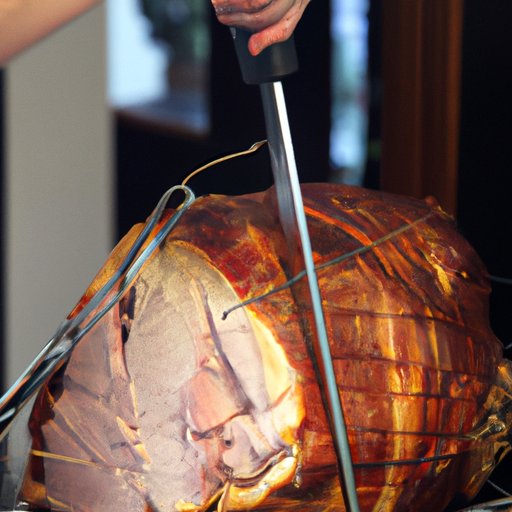
Introduction
Ham is a delicious and versatile protein that can be prepared in many different ways. However, many people struggle with the challenge of cooking ham perfectly – either it ends up overcooked and dry, or undercooked and chewy. In this article, we will provide a definitive guide to cooking ham, covering cooking times, temperatures, techniques, and tips to ensure perfect results every time.
The Definitive Guide to Cooking Ham: Cook Times & Temperature
The first step to cooking ham perfectly is understanding the different types of ham and their cooking requirements. There are three main types of ham: fully cooked, partially cooked, and fresh. The cooking requirements for each of these are slightly different.
It is also important to use a meat thermometer to ensure that your ham reaches the recommended internal temperature before serving.
To help you cook ham perfectly every time, we have created a table outlining the recommended cook times and temperatures for different types of ham:
| Type of Ham | Cooking Temperature | Cooking Time |
|---|---|---|
| Fully Cooked Ham (to reheat) | 325°F | 10-14 minutes per pound |
| Partially Cooked Ham | 325°F | 20-30 minutes per pound |
| Fresh (Uncooked) Ham | 325°F | 20-30 minutes per pound |
Ham Cooking 101: Get it Right Every Time
Choosing the right ham for your dish is an important first step in cooking ham perfectly. Consider factors like whether you want a bone-in or boneless ham, and whether you want a spiral sliced or unsliced ham. Remember to trim any excess fat and score the skin to help the ham cook evenly.
You can also experiment with seasoning and flavoring your ham through techniques such as glazing or rubbing with herbs.
When it comes to cooking the ham, there are several methods to choose from, including cooking in the oven, using a slow cooker, or grilling. We provide step-by-step instructions for each of these methods to help you achieve perfect results.
Ham 101: Everything You Need to Know About Cooking Times
Cooking times are more than just a guideline- they can greatly affect the texture and flavor of your ham. Some factors that can affect cooking times include the size, shape, and starting temperature of the ham.
We also provide solutions and tips to help you troubleshoot common problems you might encounter such as overcooking or undercooking the ham.
How to Cook the Perfect Ham – Tips and Tricks
Cooking the perfect ham can require a bit more finesse than you might realize. Our article provides insider tips and tricks such as basting the ham or even wrapping it in foil to enhance the flavor and ensure even cooking. We also cover how to test the ham for doneness without overcooking.
When it comes to serving and slicing the ham, we also provide some helpful ideas to make it look and taste picture-perfect, no matter the occasion.
Cooking Ham: A Step-by-Step Guide for Beginners
If you’re new to cooking ham, it can seem daunting to get started. This section provides simple recipes and step-by-step instructions for basic ham recipes such as ham in the oven or in a slow cooker.
We also have some tips on how to make the most out of your leftovers, so nothing goes to waste.
Understanding Ham: Cooking Times and Techniques
For those who want to delve deeper into the world of cooking ham, this section provides more detailed information on the different types of ham and their ideal cooking methods and times.
We also include some more advanced techniques, such as smoking or curing, as well as suggestions on how to adapt recipes to your individual preferences and equipment.
From Spiral Sliced to Glazed: Mastering the Art of Cooking Ham
For those who want to take their ham cooking skills to the next level, we provide some gourmet recipes and techniques for creating unique flavors and presentations.
We offer inspiration for different types of glazes and creative presentation ideas to make your ham stand out as a centerpiece of your meal.
Conclusion
Ham is a delicious and versatile protein that can be enjoyed in many ways. We hope this article has provided you with all the necessary information to cook ham perfectly every time. Remember, choosing the right ham and following recommended cook times and temperatures are important steps to success, but don’t be afraid to experiment with different flavorings and techniques. With the information provided, any reader can become an expert ham cook.





